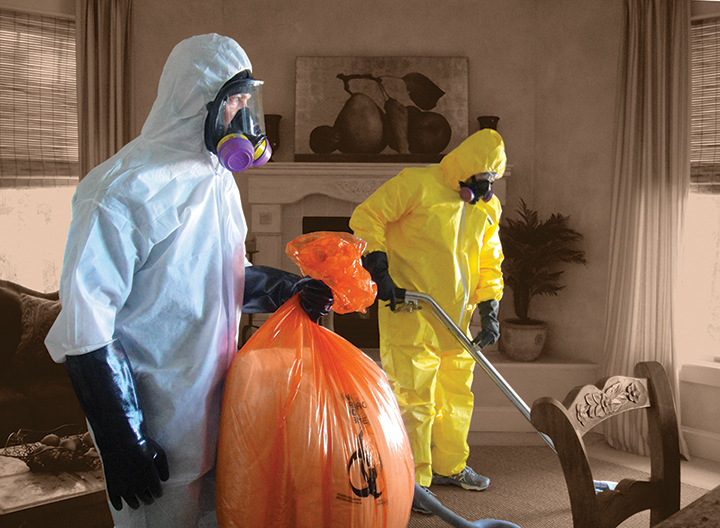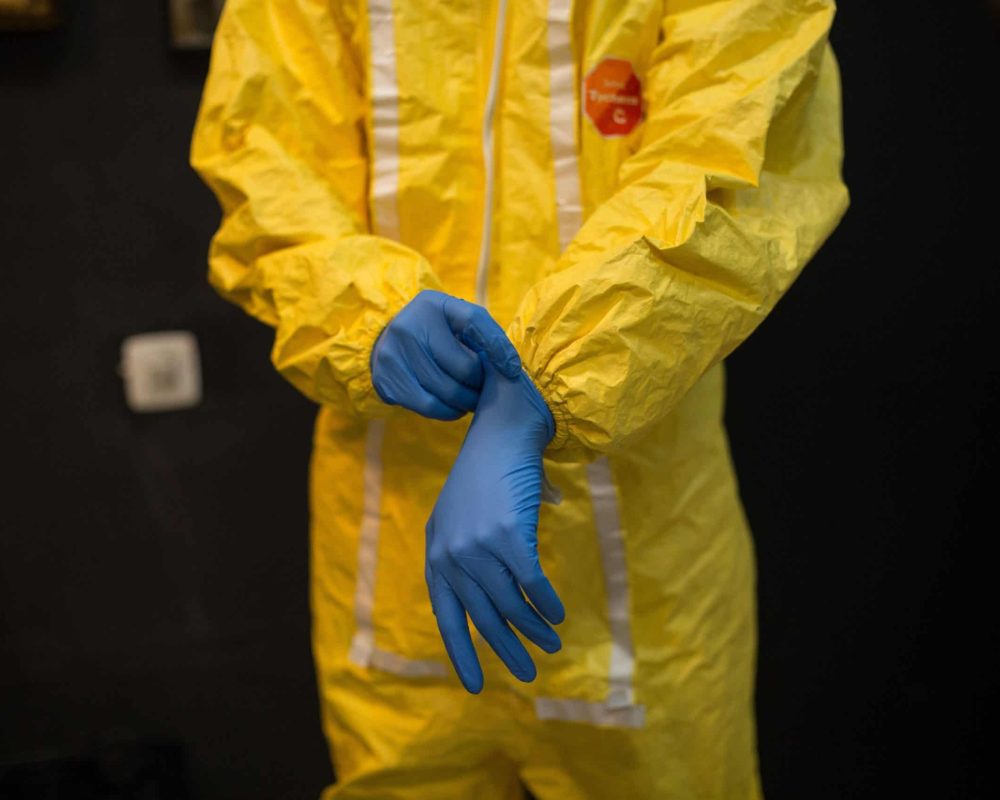Professional Blood Cleanup: Making Sure Safe and Thorough Decontamination
Professional Blood Cleanup: Making Sure Safe and Thorough Decontamination
Blog Article
Specialist Biohazard Cleaning and Decontamination for Blood, Bodily Fluids, and Hazardous Products
In the world of biohazard cleansing and purification for blood, physical liquids, and unsafe materials, precision and experience are extremely important. The potential wellness dangers related to exposure to biohazards emphasize the critical requirement for careful handling and complete cleaning. Specialized training gears up experts with the knowledge and abilities needed to resolve these hazardous situations efficiently. However, it is not merely regarding tidying up; the value of utilizing correct purification methods can not be overstated. As we navigate the intricate landscape of biohazard clean-up, understanding the nuances of guidelines, compliance, and the customized devices at play becomes important in guaranteeing a comprehensive and risk-free decontamination process.
Health And Wellness Risks of Biohazard Exposure
Exposure to biohazards presents significant health and wellness threats that can cause serious repercussions for neighborhoods and people alike. Biohazards incorporate a vast array of biological compounds, including blood, physical liquids, mold and mildew, germs, viruses, and other potentially contagious materials. When individuals come right into contact with these biohazards, whether via accidents, incorrect handling, or ecological exposure, they encounter the threat of contracting significant illnesses or conditions.
One of the main wellness dangers connected with biohazard exposure is the transmission of transmittable conditions. Bloodborne microorganisms such as HIV, hepatitis B and C, and numerous germs can be present in biohazardous products, posing a direct danger to human wellness. Breathing in airborne biohazards like mold spores or coming right into call with infected surface areas can also bring about breathing concerns, allergic reactions, and other damaging wellness impacts.
Moreover, biohazard exposure can have long-term health and wellness ramifications, with some conditions manifesting years after the first get in touch with (Blood Cleanup). As a result, it is crucial to focus on correct biohazard cleansing and purification to mitigate these health and wellness threats and make certain the safety and security of people and areas

Specialized Educating for Biohazard Clean-up
When it pertains to managing biohazard clean-up effectively and securely, specialized training plays a basic role in guaranteeing appropriate decontamination treatments are followed. Biohazard clean-up needs particular knowledge and skills to efficiently minimize risks connected with bloodborne microorganisms, bodily fluids, and dangerous materials. Specialists trained in biohazard cleaning go through rigorous guideline on how to safely manage, eliminate, and take care of biohazardous products to stop contamination and direct exposure.
Specialized training for biohazard clean-up covers a series of important subjects, consisting of proper personal protective equipment (PPE) use, bloodborne microorganism awareness, purification techniques, and contaminated materials disposal protocols. People learnt biohazard cleaning are outfitted with the needed expertise to evaluate contamination levels, identify potential risks, and execute ideal cleaning treatments in compliance with regulative standards.
Constant training and education and learning are extremely important in the area of biohazard cleanup to stay updated on the most recent purification technologies, safety procedures, and policies. By purchasing specialized training, biohazard cleaning specialists can successfully react to emergency situation cleanup scenarios and protect both public health and the atmosphere.
Significance of Proper Purification Techniques
Utilizing proper decontamination methods is crucial in biohazard cleanup to properly get rid of unsafe products and reduce wellness dangers. Effective purification not only makes certain the removal of visible traces of blood, bodily fluids, and other biohazards however additionally targets invisible microorganisms that might pose major health threats if not appropriately eliminated. By adhering to rigorous decontamination protocols, educated specialists can substantially minimize the risk of direct exposure to dangerous microorganisms, infections, and microorganisms that could bring about infections or conditions.
Correct decontamination what to use to clean up blood strategies include using customized devices and disinfectants that are particularly developed to counteract biohazards effectively. Extensive cleaning and sanitation of polluted areas are vital to prevent the spread of microorganisms and make certain a risk-free setting for owners. Additionally, the correct disposal of biohazardous waste adhering to purification treatments is essential in preventing contamination of other surface areas or individuals.

Tools and Tools for Safe Cleaning
The appropriate devices and tools play a critical function in making certain the secure and efficient cleaning of biohazardous products. When dealing with blood, physical liquids, or unsafe products, biohazard cleaning experts depend on specialized gear to decrease direct exposure risks and extensively decontaminate the affected area. Personal safety equipment (PPE) such as gloves, coveralls, safety glasses, and masks are important to shield against direct call with possibly transmittable materials. Furthermore, biohazard cleaning sets containing disinfectants, absorbent products, and biohazard bags are used to safely get rid of and include of polluted things. Blood Cleanup.
Advanced cleansing devices like hospital-grade anti-bacterials, HEPA-filtered vacuums, and misting makers are employed to sterilize surfaces and get rid of biohazards properly. Specialized tools such as sharps containers and biohazard waste disposal bins are used to securely take care of sharp items and biohazardous waste products. By using the right equipment and devices, biohazard cleaning specialists can make sure a complete cleanup procedure that prioritizes safety and reduces wellness risks for both workers and owners of the afflicted space.
Rules and Compliance in Biohazard Cleansing
Correct adherence to policies and conformity requirements is vital in biohazard cleansing to make certain the safety of both personnel and the atmosphere. Federal government agencies such as OSHA (Occupational Security and Wellness Management) and the EPA (Environmental Defense Firm) have developed certain standards for biohazard cleaning treatments to reduce health dangers and environmental contamination. These policies cover a variety of facets consisting of the handling, transport, and disposal of biohazardous products, in addition to the necessary training and protective tools needed for workers associated with the clean-up procedure.
Biohazard cleaning business have to stay updated with these guidelines to guarantee that their procedures meet the required security requirements. Failing to conform with these laws can lead to severe effects, consisting of fines, lawsuit, and endangering the health and wellness of people and the setting. By following rigid policies and conformity steps, biohazard cleansing firms can properly mitigate dangers and make certain a risk-free and detailed clean-up process for all events included.
Conclusion
In verdict, biohazard cleansing and decontamination require specialized training, proper strategies, and adherence to laws. Direct exposure to blood, physical liquids, and hazardous products positions substantial wellness dangers, making it important to make use of the right equipment and tools for secure cleaning. By following rigorous procedures and guidelines, specialists can properly reduce the threats linked with biohazard exposure and make sure the security of both themselves and others.
As we navigate the detailed landscape of biohazard clean-up, recognizing the nuances of guidelines, conformity, and the specific devices at play comes to be imperative in making certain a secure and thorough decontamination process. this contact form (Blood Cleanup)
When it comes to dealing with biohazard cleanup successfully and securely, specialized training plays an essential duty in making sure correct decontamination procedures are followed.Making use of proper purification methods is important in biohazard clean-up to efficiently remove hazardous materials and lessen health and wellness threats. Furthermore, biohazard this website cleaning packages having disinfectants, absorptive products, and biohazard bags are used to securely get rid of and include of infected products.
Federal government companies such as OSHA (Occupational Safety And Security and Wellness Administration) and the EPA (Environmental Defense Agency) have developed certain standards for biohazard cleanup procedures to minimize wellness dangers and ecological contamination.
Report this page